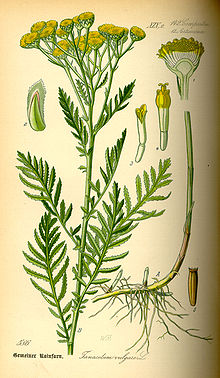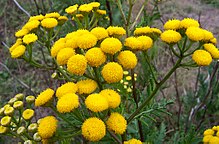Tansy
| Tansy | ||||||||||||
|---|---|---|---|---|---|---|---|---|---|---|---|---|

Tansy ( Tanacetum vulgare ) |
||||||||||||
| Systematics | ||||||||||||
|
||||||||||||
| Scientific name | ||||||||||||
| Tanacetum vulgare | ||||||||||||
| L. |
The tansy ( Tanacetum vulgare L. , synonym Chrysanthemum vulgare (L.) Bernh. ), Also tansy called, is a common Central European plant species from the family of the daisy family (Asteraceae), whose flower heads randliche ray florets missing conspicuously.
description
The tansy is a strongly sprawling, perennial herbaceous plant . It reaches a height of 60 to 130 cm. It forms a rhizome . The alternate, dark green, elongated, pinnate leaves have a strong scent. The lower leaves are stalked, the upper sessile. The whole plant contains strongly smelling essential oils ( camphor , borneol , thujone ) and bitter substances, which make attitudes to tansy a matter of taste: some people like its smell, others feel repelled by it.
He wears June to September in doldenrispigen total inflorescences bright yellow, basket-shaped part inflorescences. Overall, the flower heads as seen Gülden Knöpfle or waistcoat buttons made (so loud popular names); Children used them as play money. The smooth bracts are 4 mm long and 2 mm wide. There are no chaff leaves. The flower heads have a diameter of 1 cm, a height of 5 to 6 mm and contain about 100 hermaphrodite tubular flowers . The yellow tubular flowers are up to 2.3 mm long. Ray florets are absent.
The smooth, five-ribbed achenes about 1 mm long usually have no pappus or at most a crown-shaped border.
The chromosome number of the species is 2n = 18.
ecology
The tansy is a perennial, evergreen semi-rosette plant. In full sunlight the leaves are more or less perpendicular to the south; this behavior as a compass plant is an adaptation to the thermal radiation of sunny locations. The plant has roots up to 90 cm deep.
The flowers are feminine , radiationless "cup flowers". All flowers are hermaphroditic . Because of the only 1 mm long corolla tube, the nectar is easily accessible to all visitors; therefore the flowers are frequently visited by insects of all kinds. However, mainly pollen is offered. Flowering time is from June to September.
The fruits are wind and animal shakers; Spreading of water adhesion is also possible. Fruit ripening is from August to October.
The tansy is a creeping root, which means that its vegetative reproduction occurs abundantly through subterranean runners , i.e. clonal.
The species is spurned by grazing cattle.
Occurrence
The tansy has a Eurasian distribution. He is now a neophyte in the temperate areas of the rest of the world. There are a few varieties available for use as an ornamental plant.
The tansy grows often and gregariously in weed meadows rich in herbaceous perennials , on paths , rubble areas , dams, preferably on burns, also on banks ( river valley plant ), on warm, not too dry, nutrient-rich, weakly basic to basic, humus soils. After Ellenberg it is a light plant, suboceanic moderately nitrogen-rich locations spread a fresh pointer, indicating and a class characteristic species persistent nitrogen herb corridors ( Artemisietea vulgaris ). According to Oberdorfer, it is a character species of the Artemisio-Tanacetetum from the association Dauco-Melilotion in Central Europe, but also occurs in societies of the Arction or Chenopodion rubri.
In the Allgäu Alps, it rises in Vorarlberg on the road near Neßlegg near Schröcken up to 1400 m above sea level.
In nitrogen-rich wildlands , the tansy and mugwort bushes are often a development stage that has remained almost unchanged over the years in a succession that is not influenced by humans .
This plant species is a cultural companion and garden refugee .
use
Use as a scented plant
The strongly scented leaves and flowers of the tansy, which contain insect-repellent ingredients, used to be scattered to keep vermin away. In colonial North America, tansy was placed in coffins and shrouds were soaked in tansy extract. Tansy was also grown to drive away the Colorado beetle . According to one study, this reduced the Colorado potato beetle infestation by 60–100%. Dried tansy is used as a smoking agent in beekeeping .
Use in herbal medicine
The tansy is not found in ancient writings. The first written tradition can be found in the Capitular of Charlemagne . Tansy was previously used for worm diseases, but larger amounts than 1 to 3 grams of tansy cause symptoms of poisoning, so that today other, more effective and harmless means are used in the case of worm diseases. Its use against vermin was also widespread. Washing should drive away fleas and head lice. In veterinary medicine, the tea is given to calves and cows when they have diarrhea. As a poultice, tansy is said to help with bruises, rheumatism and varicose veins. The foliage can cause skin irritation. Tansy oil is a strong poison, the internal use of which is not harmless because it can lead to allergies and poisoning. A recent study shows that extracts from tansy are able to inhibit herpes viruses in vitro . The substances isochlorogenic acid (3,5-dicaffeoylquinic acid) (3,5-dicaffeoylquinic acid (3,5-DCQA)) and axillarin appear to be responsible for the antiviral effect.
Tansy as a coloring plant
The tansy is also used as a coloring plant . The flower heads of the tansy together with the dressing agent alum produce a dark yellow color. For the stain, 12 to 20 g of alum are used on 100 g of wool. The color becomes dark green with an alum pre- stain, iron sulphate post-stain and ammonia development bath . You need about 400 g of fresh flowers for 100 g of wool.
Tansy as an allergy plant
The tansy can be applied to the skin contact allergies cause. The triggers are sesquiterpene lactones . Parthenolide comes into consideration as the main active ingredient, along with a whole range of other contact allergens such as: Crispolid, Tanacetin, Reynosin, and 1-beta-hydroxy-arbusculin A. Florists and flower growers in particular can be affected by contact allergies.
Host plant
The tansy is the fodder for a number of caterpillars. In particular, the tansy caterpillars of the tansy monk Cucullia tanaceti , the emerald wrench Antonechloris smaragdaria , as well as other wrenches and owl butterflies can be found . The bag-carrier moth Coleophora tanaceti specializes entirely in tansy. The caterpillars of the palm moth Isophrictis striatella live in the stem of the tansy .
Two beetles live on the tansy, the tansy tansy beetle Cassida stigmatica and the tansy leaf beetle Galeruca tanaceti . There is also the tansy soft bug Megalocoleus tanaceti . The tansy tansy beetle was used together with the palm moth Isophrictis striatella and the two gall mosquitoes Rhopalomyia tanaceticola and Clinorrhyncha tanaceti, who specialize in tansy, for the biological control of tansy in the Canadian province of Saskatchewan . The wasp Torymus tanaceticola parasitizes in the galls of the tansy. Galls on tansy are also formed by the gall mite Aceria tuberculata .
The larvae of the leaf miner species Liriomyza tanaceti and Phytomyza tanaceti mine the leaves of the tansy. The rust fungus Puccinia tanaceti attacks the tansy with uredia and telia .
Tansy leaf beetle , Galeruca tanaceti , female.
Common names
The other German-language trivial names exist or existed for the tansy : Drefot ( Altmark ), Drusenkrud (Oldenburg), Jesuswurz ( Austria ), Kraftkraut, Kraftkrut (Mark near Küstrin ), Matbleamen ( Transylvania ), Michelkraut, Milchkraut ( Bavaria am Lechrain ) , Mother of God Rod, Peerknöpe (Oldenburg), Pompelblumen ( Silesia ), Presskraut (Austria near Linz ), Räuber, Rainfahn, Rainfeldblümlein ( Tyrol near Lienz ), Rainfohre ( Graubünden ), Rainvan ( Middle High German ), Regenfahn ( Mecklenburg ), Reifen ( Valais ) , Reiefa ( Ostfriesland ), Reinefaren (Ostfriesland), Reinefane, Reinewane, Reinfaor (Altmark), Reinfan, Reinfano ( Old High German ), Reinvano (Old High German), Reinfar, Reinefarn ( Göttingen ), Reinfaren, Reinfarn ( Dithmarschendeutsch ), Reinvan (Middle High German) , Renevane ( Middle Low German ), Rennefarre (Prignitz), racing fern, Revierblumen (Silesia), Revierkraut ( Thuringia ), Reynnfann (Old High German), Reynvann (Old High German), Reynfano (Old High German Tsch), Reynfarn, Reynvaen, Reynvarn (Middle High German), Reyvane (Middle Low German), Rienfaren ( Bremen ), Rinfert (Transylvania), Säfkesad (East Frisia), Seefkesad (East Frisia), Sawrsaot (Altmark), Tannkuth, Weinwermuth (Silesia) ( Memmingen ), Weisswurz (documented as early as 1482), Wormkruud (East Frisia), Wossstickenkrud (Altmark), wormweed (Austria, Eifel), Wurmkrud (East Frisia) and worm seeds ( Augsburg ).
literature
- Gustav Hegi : Illustrated flora of Central Europe. Volume VI / 4. 2nd edition 1987. Weissdorn Verlag, Jena, ISBN 3-936055-23-8 .
- Gerhard Madaus : textbook of biological remedies. G. Thieme, Leipzig 1938, Vol. 3, pp. 2667–2674 ( online at Archive.org ).
- Ruprecht Düll , Herfried Kutzelnigg : Pocket dictionary of plants in Germany and neighboring countries. The most common Central European species in portrait. 7th, corrected and enlarged edition. Quelle & Meyer, Wiebelsheim 2011, ISBN 978-3-494-01424-1 .
Individual evidence
- ↑ http://www.langenbach-info.de/Flora/Wildkraeuter_und_Graeser/Gemeiner_Rainfarn/gemeiner_rainfarn.html .
- ↑ a b Erich Oberdorfer : Plant-sociological excursion flora for Germany and neighboring areas . 8th edition. Stuttgart, Verlag Eugen Ulmer, 2001. Page 941. ISBN 3-8001-3131-5
- ↑ Erhard Dörr, Wolfgang Lippert : Flora of the Allgäu and its surroundings. Volume 2, IHW, Eching 2004, ISBN 3-930167-61-1 , p. 606.
- ↑ a b c Plants for a Future: Tanacetum vulgare .
- ↑ a b Ron LeCain and Roger Sheley: Common Tansy. Montana State University Guide ( PDF ).
- ↑ a b c G. Hegi: Illustrated Flora of Central Europe , Volume VI / 4. 2nd edition 1987. Weissdorn Verlag, Jena. ISBN 3-936055-23-8
- ↑ a b see Madaus: Textbook of biological remedies. Pp. 2670, 2671-2674 .
- ↑ Ángel L. Álvarez, S. Habtemariam: In vitro anti HSV-1 and HSV-2 activity of Tanacetum vulgare extracts and isolated compounds: An approach to their mechanisms of action. In: Phytotherapy Research. 2010, doi : 10.1002 / ptr.3382 .
- ↑ Database for Butterfly Forage Plants, Natural History Museum London .
- ^ Tansy monk in the Lepiforum .
- ↑ Emerald tensioner in the Lepiforum .
- ↑ Bag- carrier moth Coleophora tanaceti .
- ↑ Palm moth Isophrictis striatella in the Lepiforum .
- ↑ McClay Ecoscience .
- ↑ Tanacetum. Tansy, Costmary and Feverfew [Asteraceae]. Leaf and stem mines of British flies and other insects.
- ↑ Peter Zwetko: The rust mushrooms Austria. Supplement and host-parasite directory to the 2nd edition of the Catalogus Florae Austriae, III. Part, Book 1, Uredinales. (PDF; 1.8 MB).
- ↑ Tamara Ramsay : Wonderful rides and adventures of the little Dott. Union Deutsche Verlagsgesellschaft, Stuttgart 1938, or Prignitz-pur-Verlag, Meyenburg 2007.
- ^ Georg August Pritzel , Carl Jessen : The German folk names of plants. New contribution to the German linguistic treasure. Philipp Cohen, Hanover 1882, page 96 f. ( online ).
Web links
- Tansy. In: FloraWeb.de.
- Tansy . In: BiolFlor, the database of biological-ecological characteristics of the flora of Germany.
- Profile and distribution map for Bavaria . In: Botanical Information Hub of Bavaria .
- Tanacetum vulgare L. In: Info Flora , the national data and information center for Swiss flora . Retrieved May 13, 2016.
- Distribution in the northern hemisphere according to Hultén
- Thomas Meyer: Data sheet with identification key and photos at Flora-de: Flora von Deutschland (old name of the website: Flowers in Swabia )
- The poisonous plant tansy.
- The poisonous plant tansy as a medicinal plant.
- Characteristics.
- The species as a medicinal plant
- Description in the Flora of North America (English)







